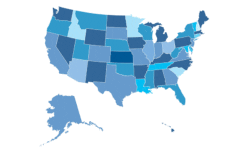On Patrol: It’s Time to Reorganize
As corporate director of protective services at OhioHealth healthcare system, one of FORTUNE Magazine’s “100 Best Companies to Work For,” Charles Smith has transformed his department by uniting security teams from the five hospitals under his leadership into one organization.

For most, it’s difficult to work under the direction of multiple managers, especially if those sources are going in completely opposite directions. It can be very confusing for anyone, but when it comes down to security at a hospital, the confusion could literally mean the difference between life and death.
Enter Charles Smith, corporate director of protective services at OhioHealth healthcare system. As the head of at least five separate campuses, Smith previously reported to two vice presidents, each with his own concerns at different locations. With that in mind, Smith sought to merge each security team into one corporate department under the leadership of one individual who reports to a single authority.
Unifying the subset of groups proved to be successful, and Smith didn’t just stop there. He heads one of the most successful drug diversion programs in the country. Additionally, he revamped the hiring method the healthcare system used for new hires in the security field to include the opinions of others in the department.
You’re now in charge of protective services of all the hospitals. How did the reorganization of the department come to pass?
SMITH: I previously had two different bosses at one time. One was responsible for one hospital, and one was responsible for another hospital. I also had responsibilities at other locations where people were calling me for investigations and security services. However, those areas weren’t the responsibility of my previous bosses. They really didn’t care that I’d had a break-in at the Southwest Health Center because that really wasn’t their area of concern.
We presented a paper to the president’s group explaining what we thought would be more representative of what we should be doing as an organization to protect everyone. Upper administration was very supportive of that. They agreed that we had gotten big enough, and we needed to have security at all locations reporting under the leadership of one person.
How long did the reorganization take?
SMITH: A couple of years. It wasn’t something that was a quick process. It goes back to financing. Our challenge was to remain flat, so we took all of the employees and formed one corporate department. All of the officers had to receive new training because the officers at all the different locations were not receiving the same training, nor were they required to receive the same training.
What are the biggest challenges facing your department?
SMITH: Our biggest challenge is to maintain an open environment while protecting our 16,000 associates, patients and visitors. Traditionally, hospital administrators want to maintain a customer/patient friendly venue. Also, as a consumer, you wouldn’t want to visit a friend, loved one or family member in a hospital where it feels like Fort Knox. It’s very difficult and very challenging to maintain that openness and provide a safe environment.
Another area that’s a challenge is recruitment, especially in the area of recruiting a diverse workforce. We’re striving to meet the changing diversity of our community, and we’re competing for those recruits with the public police departments.
How are you addressing recruitment?
SMITH: We’re getting ready to implement a grad program. Prior to this, we required Ohio police officer certification for all of our officers, meaning that our officers needed to have the same certification that a city police officer has in the state. That is essentially a 640 hour program.
Now, we’re starting an internal grad program, which allows any employee in our system to apply to be an officer, even if they don’t have their certification. In most cases, they won’t. Each applicant must have the same qualifications as any officer or candidate coming off the street. He/she must complete the interview process, which includes a polygraph test and a psychiatric screening. The officer must have three letters of recommendation — one of which has to be from the manager of his/her current department. If the applicant makes it through the screening process, we decide whether or not that person would make a good officer. Then, the staff will bring that person onboard and pay for him/her to go to the academy.
The academy costs about $3,000. The applicant has to sign an agreement that’s been drafted by our legal department that says he or she will stay with us for two years after graduating from the academy. If the person doesn’t stay, the cost of the academy will be prorated. In other words, if he/she stays with me for one year after graduation, he/she owes me $1,500, which will be deducted from the last check.
One thing I should add is that they not only have to go to the academy, but they have to graduate. They have to meet all the requirements, including the physical requirements, which are challenging. It’s a regular police academy. They have to pass the exams; they have to pass the physical.
Speaking of recruitment and hiring, you also implemented a new hiring system. What prompted the change?
SMITH: We really wanted to get our staff more involved in the [hiring] process. Prior to changing our system, our deputy chiefs would interview candidates at each individual campus. Then, they would send anybody they liked over to me. Now we have an interview panel that we put together, and it’s pretty intense. Generally, there is a minimum of six people on the panel asking questions to the candidates. After the panel evaluates and rates the applicants, they’ll select their best two or three and send them to me, and then I will send them on to the next step, which is a polygraph and psych screen.
We implemented the panel to get a better overall view. We wanted to get more people in the department involved in the selection process because they’re the ones who have to work with these people.
What kinds of initiatives is your department working on right now?
SMITH: One of the big things is the cross training from campus to campus. We are trying to make sure that officers are competent at all campuses. If there is an incident or some type of disaster occurring at one of our campuses, we need all officers to be proficient. If I call one of the shift supervisors at another campus to send me a couple of officers from his/her shift and the officers don’t know where to go for roll call, then we have a problem. It’s very important that we train our people.
Another thing we’re working on is an attempt to save overtime for department meetings, so we’re going to start filming meetings. Normally, when we have a department meeting, I lead the meeting and pass along the necessary information. Now, we’re going to produce a video and pass it out at all the facilities. Employees will be required to sit down at the computer and listen to me discuss what’s going on. We’re asking everyone to submit any questions ahead of time that they want answered, and I’m really hoping this will work.
What’s your biggest accomplishment since the reorganization?
SMITH: One of the things we’re really proud of here is what I believe to be one of the best drug diversion investigative units in the country. I have yet to find someone else who is doing exactly what we’re doing.
We monitor the PYXIS machines (a machine designed to dispense and record the use of hospital drugs), and we have a software tool that compares the usage on each PYXIS machine between nurses. We’re working with the police as well. In fact, our program is such that the Columbus police just let us handle whole investigations ourselves. They don’t even get involved until after the interview process and we’ve got a confession (if one is necessary).
One of our senior investigators presented at the NADDI (National Association for Drug Diversion Investigators) conference, one of our pretty significant events. We have a pretty good reputation in the community. I think statewide, and even a little bit nationally, people are recognizing what we’re doing as being pretty much a benchmark in the industry.
The Smith File
Name: Charles Smith
Title: Corporate Director of Protective Services
Campus: The OhioHealth healthcare system has 17 hospitals and 20 health and surgery centers across 46 counties. Combined, the hospitals have more than 2,000 beds and approximately 16,000 employees.
Department: The protective services team consists of 100 sworn officers; 15 nonsworn officers; and an administrative staff of seven individuals.
Experience: Smith has been in healthcare law enforcement for 29 years. He’s previously worked at the Children’s Hospital in Columbus, Ohio; Ohio State University and served as police chief of one of the Columbus suburbs. He’s been the director of OhioHealth’s protective services department for 16 years.
Related Articles:
- The Elite 8: CS Director of the Year Finalists Revealed
- Extreme Makeover: Hospital Edition
- Recruiting in a Tight Labor Market
- Hospital Security Department’s Rx: Change
- The Road to Competitive Salaries: 2 Steps Forward, 1 Step Back
- Survey Says … You’re Happy
- Ms. Stafford Goes to Washington
- Here’s to You Mr. Robinson
- How Much Are Your Campus Officers Worth?
Ashley Willis is assistant editor of Campus Safety. She can be reached at ashley.willis@bobit.com.
To subscribe to the unabridged print version of Campus Safety magazine, click here.
If you appreciated this article and want to receive more valuable industry content like this, click here to sign up for our FREE digital newsletters!
 Leading in Turbulent Times: Effective Campus Public Safety Leadership for the 21st Century
Leading in Turbulent Times: Effective Campus Public Safety Leadership for the 21st Century
This new webcast will discuss how campus public safety leaders can effectively incorporate Clery Act, Title IX, customer service, “helicopter” parents, emergency notification, town-gown relationships, brand management, Greek Life, student recruitment, faculty, and more into their roles and develop the necessary skills to successfully lead their departments. Register today to attend this free webcast!







